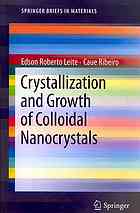

Most ebook files are in PDF format, so you can easily read them using various software such as Foxit Reader or directly on the Google Chrome browser.
Some ebook files are released by publishers in other formats such as .awz, .mobi, .epub, .fb2, etc. You may need to install specific software to read these formats on mobile/PC, such as Calibre.
Please read the tutorial at this link: https://ebookbell.com/faq
We offer FREE conversion to the popular formats you request; however, this may take some time. Therefore, right after payment, please email us, and we will try to provide the service as quickly as possible.
For some exceptional file formats or broken links (if any), please refrain from opening any disputes. Instead, email us first, and we will try to assist within a maximum of 6 hours.
EbookBell Team

4.1
90 reviewsSince the size, shape, and microstructure of nanocrystalline materials strongly impact physical and chemical properties, the development of new synthetic routes to nanocrystals with controlled composition and morphology is a key objective of the nanomaterials community. This objective is dependent on control of the nucleation and growth mechanisms that occur during the synthetic process, which in turn requires a fundamental understanding of both classical nucleation and growth and non-classical growth processes in nanostructured materials. Recently, a novel growth process called Oriented Attachment (OA) was identified which appears to be a fundamental mechanism during the development of nanoscale materials. OA is a special case of aggregation that provides an important route by which nanocrystals grow, defects are formed, and unique—often symmetry-defying—crystal morphologies can be produced. This growth mechanism involves reversible self-assembly of primary nanocrystals followed by reorientation of the assembled nanoparticles to achieve structural accord at the particle-particle interface, the removal of adsorbates and solvent molecules, and, finally, the irreversible formation of chemical bonds to produce new single crystals, twins, and intergrowths.
Crystallization and Growth of Colloidal Nanocrystals provides a current understanding of the mechanisms related to nucleation and growth for use in controlling nanocrystal morphology and physical-chemical properties, and is essential reading for any chemist or materials scientist with an interest in using nanocrystals as building blocks for larger structures. This book provides a compendium for the expert reader as well as an excellent introduction for advanced undergraduate and graduate students seeking a gateway into this dynamic area of research.